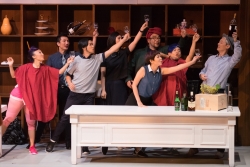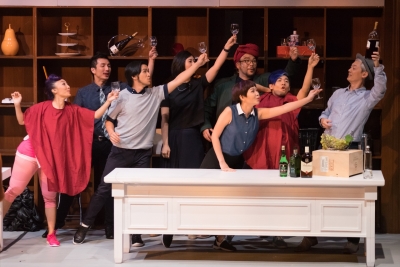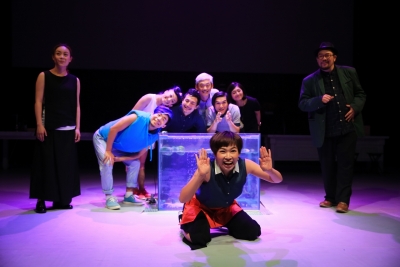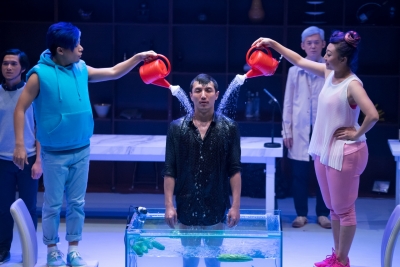 |
Postcolonial Affairs of Food and the Heart by Yesi, performed by On&On. Director: Chan Ping-chiu. Adaptation Playwright: Chan Ping-chiu. Original text: Postcolonial Affairs of Food and the Heart (2009), author: Yesi. Company: On&On. Premiere: Studio Theatre, Hong Kong Cultural Center, May 20, 2016.
Yesi (1949-2013), eminent Hong Kong writer and scholar, was dedicated to promoting Hong Kong literature and sought to tell a Hong Kong story all his life. Postcolonial Affairs of Food and the Heart (2009) is his representative work. The novel consists of eleven short stories, with its protagonists living across different stories and relationships. The work is set in post-1997 Hong Kong, though recollections to pre-handover occupy a considerable proportion and bear no less importance. In 2014, Chan Ping-chiu, veteran director from the local theatre group On&On, selected three stories from this book, namely, the stories of Stephen, Emily and Lo Sit, and put them into a theatre adaptation. Stephen is a bar owner in his thirties, Emily is a suburban girl who went out to the Central Business District of Hong Kong to earn a living and Lo Sit is an experienced food critic, also known as “God of Food.”
The poster for the production. (Photo by Cheung Chi Wai)
The focus of Chan’s attempt in 2014 was the legendary figure Lo Sit, the wanderer who had lived through the last half-century of Hong Kong and tasted almost every flavor of the city, witnessing its up and downs, as well as those of his own career. Chan successfully wove the three different stories together into a lively piece capturing significant moments of Hong Kong. The work received wide praise at the time. Two years later, with much expectation from theatre fans, Chan put forward his second attempt. He shifted the focus and showed a broader vision. This article reviews the new adaptation, with the 2014 version as a point of comparison.
From Narration to Expression, From Call to Autonomy to Quest for Identity
The first major change is Chan’s reset of the background: he moved the story ahead to the autumn of 2014. This change is indicative. The autumn of 2014 is actually during the Umbrella Movement. Chan added a sequel episode to Yesi’s novel: Siu Suet, the apprentice of Lo Sit, came back to Hong Kong from Taiwan in order to attend Lo Sit’s funeral, and she witnessed the turbulence of the unprecedented social movement. The death of Lo Sit led to the search for his manuscript of “The Book of Food,” an all-encompassing compendium of food that he had longed for almost his whole life. As Siu Suet was searching for her master’s lost manuscript, she had a dream in which the stories of Stephen, Emily and Lo Sit were called back.
Compared with the first adaption, the story of Lo Sit is considerably shortened and the spotlight is on the apprentice. Chan’s choice to use Siu Suet, the living young apprentice, as a key in narrating the play, suggests that he had young people in mind as his target audience. In the play, Lo Sit told Siu Suet explicitly, “It is not about us anymore. It is about your generation.”
Emily (center) talks to the audience about her happy childhood memories. (Photo by Cheung Chi Wai)
The new adaptation is no longer limited to narrating the adventurous life trajectory of a legendary figure in food critic circles. Chan’s ambition goes beyond that. He reveals the bigger context—for instance, issues of food safety, environment protection, human relationships, cross-border political tension, etc.—and he disturbs the daily and normal life of the city dwellers through multiple representations of these issues on stage. Chan, the homegrown director, injects his depression, anger, regrets and hope into Yesi’s characters and stories, and gives them vital new life in the theatre adaptation. The number of monologues are increased compared to the 2014 version, and the increase offers a more articulated and nuanced account of the psychological struggles of the characters, such as feeling lost, confused, anxious and almost helpless.
The deep social concern of the director is obvious throughout the whole play. “Should you be able to choose what to put into your own mouth, you become an independent person.” The repeated appearance of this line represents the consistent theme of “autonomy and independence,” which lingered throughout the last version. And, in the new edition, Siu Suet sighed that food is unlike a lover whom one can freely choose, and she admitted that one’s taste is closely related to upbringing, family background, local culture, social practices, etc. The theme, therefore, extends to a discussion on the issues of “identity and roots.” This was especially critical to the social context when the play was premiered—Hong Kong society in 2016, in the aftermath of the Umbrella Movement.
Exploring Theatrical Form, Experiencing Theatrical Ritual
There is another significant change from the 2014 version: one dramatic arrangement to the set and structure, which, in turn, creates a unique and distinctive theatrical experience.
In the first half, the stage was clean and elegant, matching the melancholy stories of Stephen and Emily. Plain white, long table, a back wall of cubes with different furnishings and utensils. The set conveyed a graceful atmosphere. The site was filled with cooking smell (as the cast did real cooking at the site) and the story was seasoned with well-balanced jokes: the mixed influences of Chinese and British cultures, practical, cheerful and positive, though mingled with a sense of rootlessness. At center stage, was a transparent glass box. It was about human size and filled with water. The glass box served as a container, in both physical and symbolic senses: it was where Stephen drowned himself in the memories of his childhood and teenage years, and where Emily dropped all her toys and gloomy reminiscences. Local choreographer Mui Cheuk-yin, well known for her elaborate management of props and exquisite expression of emotions, was invited to act as choreography director. The actors took up more body movement (including solo dance, group dance and symbolic movement), replacing a fair number of lines in the 2014 version. To take one instance, the actors did lots of climbing over, moving along and dancing on the long table, with the balance point uplifted, implying a sense of unsettledness and the uprooted sentiment.
Stephen (center) is “drowned” in water and in his nostalgic recollections of Hong Kong in the past. (Photo by Cheung Chi Wai)
The set of the second half marked a complete divergence. The white-and-clean style was replaced with a disturbing black tone with broken-down furniture scattered on the floor, signifying the destruction and loss of life. A stunned disconnection. To a certain extent, “post-”, in the title of the show, is both a divider and a connector, as is also reflected in the free and seemingly unscripted discussion of the actors of the term “post-colonialism” in the first half.
The voice-over was based on another queer story from Yesi’s book, in which a group of Hong Kong friends gathered from different places and went to try the famed cuisine of Aibre in France. The Aibre Feast is famous for its creative and experimental style, providing an unforeseeable menu of dishes and delivering magical tasting experiences. As the narration went on describing the served dishes one by one, the performers, all in priestly dress of black hat and black coat, were entering and dropping the dishes into the glass box one by one. The theatre space became divine and serene. The sinking ritual moving on, the story unfolded, the friends found out the following day that the latecomers, a couple of lovers in white, who joined them to enjoy the rest of the ceremonial meal, were in fact killed in a car accident before the dinner. In the meantime, the two main actors were pouring two sticky colors into the glass cube—white and black, sinking and disseminating, invading each other yet maintaining their essences, until the boundary blurred, division became unclear. The theatrical representation of the ghost story was absorbing yet distressing, sacred yet intriguing. Audience members at the scene may feel as if they are going through a complete ritual: they were no longer a theatre audience; they were back to the origins of theatre—sacred ritual, ghosts hanging in the air.
This is an ode to the theatre by the director, alongside his social concerns. It was hinted by one original line in the novel “the whole [serving] ritual… was indeed like a theatre performance” (brackets added by the present author). And the metaphor was reversed in Chan’s adaption.
If ritual is a collective ceremony, a process to pursue the transcendent part of the human spirit and to remind each of its attendees of it, the theatre may evoke a similar function. On&On’s new adaption of Postcolonial Affairs of Food and the Heart in 2016 is a timely reminder in well-executed theatrical form.
*This article is based on my review published in Artism (July 2016), an online magazine by IATC (HK). The original review is in Chinese. The text can be found in http://www.iatc.com.hk/doc/90440 .
(原載於December/Décembre 2017: Issue No 16《Critical Stages/Scènes Critiques》)
本網站內一切內容之版權均屬國際演藝評論家協會(香港分會)及原作者所有,未經本會及/或原作者書面同意,不得轉載。












